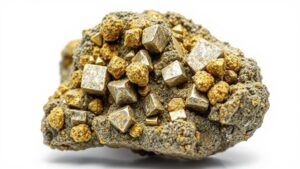Secrets of Using Rock Discoloration to Trace Silver-Rich Veins
Secrets of Using Rock Discoloration to Trace Silver-Rich Veins
The identification and extraction of silver from mineral deposits have long fascinated geologists and miners alike. A lesser-known, yet powerful technique in this field involves analyzing rock discoloration. This article explores how rock discoloration serves as an invaluable indicator of silver-rich veins, highlighting key methods, real-world applications, and the science behind it.
The Science Behind Rock Discoloration
Rock discoloration often results from various geological and chemical processes that alter the color of the host rock. Particularly important in the context of silver mining, these color changes frequently signify the presence of silver-bearing minerals. Discoloration can occur due to oxidation, weathering, or the deposition of secondary minerals.
For example, silver minerals such as argentite (Ag2S) can lead to noticeable changes in the coloration of the surrounding rock due to their distinct chemical properties. The iron present in these minerals can oxidize and create vivid red or yellow hues as it reacts with oxygen and moisture. By recognizing these changes, prospectors can more accurately identify potential silver-rich veins.
Using Discoloration as a Geological Indicator
To leverage rock discoloration in identifying silver veins, several techniques are employed:
- Field Surveys: Miners conduct extensive visual inspections of rock formations, noting any unusual discoloration that could suggest mineralization.
- Geochemical Analysis: Soil and sediment samples are collected from areas exhibiting discoloration to analyze for silver and accompanying trace elements.
- Remote Sensing: Advanced satellite imagery can help identify large-scale mineralization patterns which may be indicative of underlying silver-rich veins.
Case Study: The Comstock Lode
The Comstock Lode, discovered in Nevada in 1859, serves as a historical example of utilizing rock discoloration to identify silver-rich veins. Miners noted specific discoloration patterns in the surrounding quartz and sedimentary rocks. The presence of iron oxides, evidenced by yellow and reddish hues, was often associated with rich veins of silver-bearing galena (PbS) and other minerals.
This method not only led to the discovery of notable silver deposits but also contributed to advances in mining techniques and geochemical analysis that are still in use today.
Practical Applications in Modern Mining
Understanding how to trace silver-rich veins using rock discoloration has practical applications in today’s mining industry. Companies are increasingly employing a combination of traditional prospecting and cutting-edge technology to optimize their exploration strategies. Some notable applications include:
- Augmented Reality (AR): New AR technology allows geologists to superimpose geological information, including discoloration data, onto physical landscapes, enhancing field exploration.
- Geospatial Data Integration: By integrating discoloration analysis with Geographic Information Systems (GIS), miners can create detailed maps that highlight areas of interest for further exploration.
Challenges in Interpretation
Although discoloration can indicate the presence of silver, interpreting these signals is not without its challenges. Variables such as:
- Geological complexity: Diverse rock types and structures can create misleading discoloration patterns.
- Environmental factors: Human activities and natural processes can alter surface conditions, masking underlying mineralization.
To address these concerns, a comprehensive approach that combines visual inspection, geochemical data, and modern technology is recommended. Employing multiple methods allows for cross-validation and increases the likelihood of accurate vein identification.
Conclusion
Tracing silver-rich veins through rock discoloration is a time-tested technique that continues to yield valuable insights in mineral exploration. By understanding the science behind discoloration and effectively applying modern technology, mining professionals can optimize their search for silver and other precious resources. As innovation in geology and mining technology progresses, the wisdom drawn from methods of the past remains a vital part of the industry’s future.
Actionable Takeaways:
- Conduct thorough field surveys while monitoring for unusual discoloration patterns.
- Use geochemical analysis to support visual assessments with quantitative data.
- Incorporate advanced technologies, such as GIS and AR, to improve exploration efficiency.


